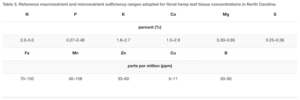
NC State Releases Nutrient Reference Ranges for Floral Hemp
A new NC State Extension publication is available covering hemp leaf tissue nutrient ranges. This information is important for monitoring hemp nutrient status throughout the season. The researchers that authored the “Hemp Leaf Tissue Nutrient Ranges: Refinement of Reference Standards for Floral Hemp” report are David Suchoff, assistant professor and Extension Specialist; Michelle McGinnis, Agronomic Field Services section chief at the North Carolina Department of Agriculture and Consumer Services; Jeanine Davis, Extension specialist; Brian Whipker, professor; Kristin Hicks, section chief, Plant/Waste/Solutions/Media Lab, Agronomic Division, North Carolina Department of Agriculture and Consumer Services.
View the report below.
Proper nutrient management is one of the cornerstones for any successful crop production system. Underapplication of nutrients can lead to crop deficiencies and suboptimal yields. Conversely, overapplication of nutrients is economically wasteful and, in extreme cases, can lead to crop toxicity or leaching, which negatively impacts the surrounding environment. Monitoring crop nutrient status throughout the season via leaf tissue analyses is the most effective means of ensuring that fertility needs are met. Once leaf tissue is analyzed, the resultant nutrient concentrations are compared to established references ranges, which determine if specific nutrients are being underapplied or overapplied. Reference ranges exist for most of our agronomic crops. However, these ranges are not universal, and when a new crop is introduced, research must be conducted to establish these sufficiency ranges.

Hemp (Cannabis sativa L.) has been produced commercially in North Carolina since 2017. As a newly legal crop, little information exists about optimum nutrient levels in the plant. Initially, the only source for hemp leaf tissue nutrient information was Bryson and Mills (2014) (Tables 1 and 2). That information was invaluable for providing the only baseline references available at the time, but the Bryson and Mills ranges are based on a small data set (25 leaves) from a greenhouse production nursery with unreported varieties or type—cannabidiol (CBD) versus tetrahydrocannabinol (THC). A published greenhouse survey of five CBD varieties (Landis et al. 2019) followed by a second survey of thirteen CBD varieties (Kalinowski et al. 2020) provided the first foliar nutrient studies of hemp varieties grown in North Carolina. Of additional importance, a greenhouse nutrient disorder study of a CBD variety common to North Carolina established the foliar nutrient concentration associated with the observance of deficiency symptomology (Cockson et al. 2019).

In an effort to create a cohesive set of leaf tissue nutrient reference ranges for floral CBD varieties grown in North Carolina, 6,119 hemp plant tissue samples were collected from 76 North Carolina counties and submitted to the North Carolina Department of Agriculture & Consumer Services (NCDA&CS) Agronomic Division between 2017 and 2020. These samples were analyzed for N, P, K, Ca, Mg, S, Fe, Mn, Zn, Cu, and B. The >100 Cannabis sativa varieties included in this robust survey were grown for CBD production in both field and greenhouse systems. Reference ranges for each element were calculated using a quartiles approach on the population distribution of the sample set (Figure 1), and the recommended sufficiency range was the 50% of samples between the first (Q1; 25th percentile) and third (Q3; 75th percentile) quartiles.
Comparison of elemental concentrations in field and greenhouse samples showed similar distributions and medians and thus were combined into one survey to produce a single set of recommended sufficiency ranges for this crop for both production systems. The comprehensive survey ranges were compared to the ranges reported by Bryson and Mills (2014), Landis et al. (2019), and Kalinowski et al. (2020), which were used to refine and validate the proposed ranges. The sufficiency ranges determined from this data set by North Carolina State University and NCDA&CS and adopted by NCDA&CS for floral (CBD) hemp plant tissue analysis in North Carolina are reported in Table 3.

The reference values for floral hemp (Table 3) were derived from a very large survey representing most floral hemp varieties grown in North Carolina, multiple production years and production systems, and a wide range of soil types. Given this robust set of data, the nutrient ranges presented in Table 3 can be used as a guide for farmers, consultants, and North Carolina Cooperative Extension agents as they seek to manage their nutrient programs. These ranges may serve as an acceptable estimate of expected nutrient levels in Cannabis sativa until additional information from sufficiency range studies becomes available. These values were generated only from floral hemp. Whether these ranges are applicable to grain or fiber hemp must still be investigated.
How to Collect a Hemp Sample for Plant Tissue Analysis
During vegetative growth, collect one or two fully expanded, most recently mature (MRML) or most recently expanded leaves—generally the third to fifth leaf down from the growing point— from 10 to 20 plants (pictured at top). Place samples in a paper bag and submit as soon as possible to the Agronomic Services section of the NCDA&CS for analysis. Local Extension agents in your county can help with the collection and submission of samples.
For more information, visit https://content.ces.ncsu.edu/hemp-leaf-tissue-nutrient-ranges.



